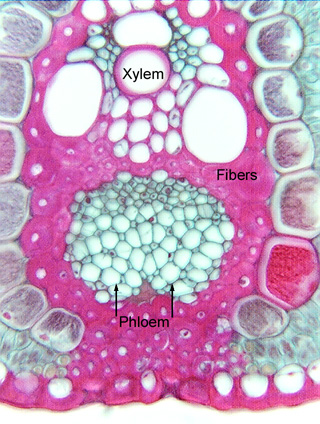 Fig.
8.1-2. Transverse section of vascular bundle in a leaf of a grass (Botelua).
Grasses are monocots, so this phloem shows the regular, easy-to-recognize
organization typical of monocots (similar to Fig. 8.1-1). All the large, white
cells are sieve tube members, all the small cells with dots (nuclei) are
companion cells. Notice that the phloem is separated from the xylem by a barrier
of fibers. Having a sheath of fibers is common for monocots, but this barrier
between the two vascular tissues is a little unusual.
Fig.
8.1-2. Transverse section of vascular bundle in a leaf of a grass (Botelua).
Grasses are monocots, so this phloem shows the regular, easy-to-recognize
organization typical of monocots (similar to Fig. 8.1-1). All the large, white
cells are sieve tube members, all the small cells with dots (nuclei) are
companion cells. Notice that the phloem is separated from the xylem by a barrier
of fibers. Having a sheath of fibers is common for monocots, but this barrier
between the two vascular tissues is a little unusual.